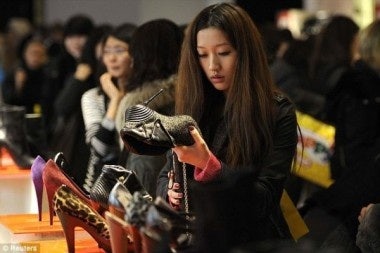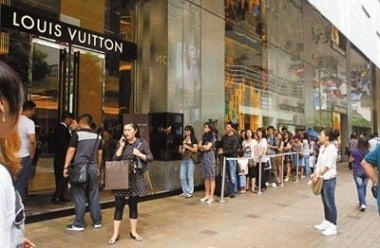World Luxury Association Rep Ouyang Kun Sheds Light Onto Chinese Luxury Market#

The WLA estimates that 75 percent of Asian tourist-shoppers in Europe last year were Chinese
According to the recent 2010-2011 annual report by the World Luxury Association (WLA), as of March 2011, the Chinese luxury market now accounts for a quarter of global market share, totaling US$10.7 billion, even before factoring in private aviation, yachts and luxury cars. Despite the 30 percent growth registered last year in China's domestic luxury market, however, Chinese spending at home remains dwarfed by spending abroad. It's an established fact at this point that--absent the significant luxury taxes, privacy concerns, and sometimes limited inventory seen in mainland China--some of the top-spending outbound tourist-shoppers do virtually all of their high-end shopping in Europe, Hong Kong and elsewhere. But an interesting (if frustratingly vague) finding by the World Luxury Association is that Asian shoppers, 75 percent of whom were Chinese, accounted for 65 percent of luxury sales in the "major shopping regions" in France, Italy and the UK from March 2010 to March 2011.
Of the US$69 billion the World Luxury Association says Asian tourist-shoppers spent on luxury goods in Europe last year, nearly $50 billion was spent by Chinese, meaning these individuals spent four times as much on luxury goods abroad as they did at home.
This has implications not only for the young domestic Chinese luxury market but the comparatively ancient European market as well. According to the Chinese news site China.org.cn, "more than 80 luxury boutiques" in Europe currently offer Chinese-language service, and the inclusion of Mandarin-speaking staff is one of the key factors that drives sales among Chinese outbound shoppers. As Jing Daily wrote last month, a growing number of luxury brands are already fully aware of this. Cartier's new boutique in Madrid has prioritized the recruitment of Chinese-speaking staff, and Olivier Gay, general manager of Cartier Spain, recently said that Cartier now considers how best to cater to Chinese shoppers when planning new locations in Europe. As the WLA notes in its latest survey, the prospect of high-end shopping has now become one of the top drivers for Chinese to plan a trip abroad, and if the gap between domestic and overseas luxury spending continues along this path, we'll see "increasingly serious consumer outflows" going forward.
So what can be done to address China's high-end "wallet drain"? The WLA suggests five steps, which in many ways echo what we heard in March from Dalian Wanda chairman Wang Jianlin:
1. Adjust the luxury tax and refine the country's duty-free policy
2. Reduce trade frictions and raise China's luxury market to global standards
3. Develop standardized regulatory policies regarding luxury pricing and sales
4. Take greater action against the counterfeit market and strengthen IP protection
5. Increase the cultivation of a luxury consumer culture

Chinese tourists line up at a LV boutique in France
Somewhat bland suggestions, but nothing we haven't heard before. As observers like Wang Jianlin and the WLA are quick to point out, the price difference between luxury goods in China and overseas is perhaps the greatest thing hindering domestic sales, and an area that requires rethinking on the part of Chinese tax authorities. As the latest WLA study notes, among three (again, frustratingly, unspecified) top high-end watch, apparel and handbag brands, prices in mainland China are on average 45 percent higher than in Hong Kong, 51 percent higher than the United States, and 72 percent higher than in France. No wonder long lines of mainland Chinese tourist-shoppers are a common sight at Louis Vuitton stores around the world.
As Ouyang Kun of the World Luxury Association pointed out this week, Chinese luxury buyers can mostly be broken down into three groups: those who shop overseas (57 percent), those who buy "through sales channels" like Taobao or second-hand shops (23 percent), and those who shop at local, physical boutiques (20 percent). What's interesting about these figures--and should prove somewhat depressing for luxury brands--is that the vast majority of the 20 percent of people who bought luxury goods locally did so with the intention of giving these items away as gifts to "government officials, university professors, or business owners." Again, the 80 percent of shoppers who sought to sidestep China's stiff luxury taxes via online shopping, second-hand shopping or overseas trips were essentially led by price and selection above all other factors.
Is there any hope that China will lower its luxury taxes to spur domestic spending and prevent Chinese consumers from, as Wang Jianlin put it, "sitting on airplanes to deliver jobs and tax money to foreign countries”? At the moment, the Chinese government is giving few signs that it's even a priority. Instead, in its 12th five-year plan, Beijing prioritizes the creation of home-grown Chinese luxury brands to compete with international brands on their home turf. While this might make for good copy, and we are indeed seeing more local brands move up the value chain, for the time being it means that European retailers will keep counting the piles of cash left behind by Chinese tourists while many luxury boutiques in mainland China remain devoid of shoppers.